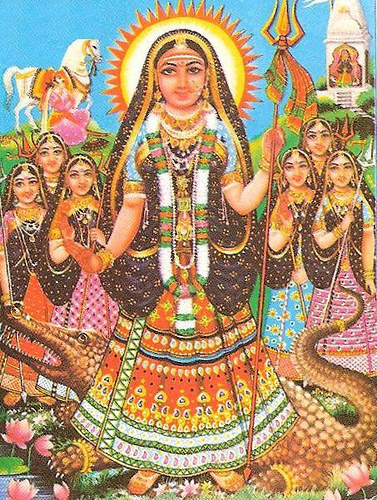The Goddess of never not broken.
You know that feeling when you have just gone through a breakup, or lost your job, and everything is terrible and terrifying and you don’t know what to do, and you find yourself crying in a pile on your bedroom floor, barely able to remember how to use the phone, desperately looking for some sign of God in old letters, or your Facebook newsfeed or on Glee, finding nothing there to comfort you?
Come on, yes you do. We all do.
And there is a goddess from Hindu mythology that teaches us that, in this moment, in this pile on the floor, you are more powerful than you’ve ever been.
This past week, I have been deeply inspired by a talk I heard on the Yoga Teacher Telesummit by Eric Stoneberg on this relatively unknown Goddess from Hindu mythology: Akhilandeshvari.
This figure has snuck up inside me and settled into my bones. She keeps coming out of my mouth every time I teach, and she’s given me so much strength and possibility during a time of change and uncertainty in my own life. I wanted to unpack a little bit about who she is for those that might be, like me, struggling a little bit in that pile on the floor and wondering how the hell to get up again.
The answer, it turns out, is this: in pieces, warrior-style, on the back of a crocodile. Yee ha.
Akhilandeshvari:
“Ishvari” in Sanskrit means “goddess” or “female power,” and the “Akhilanda” means essentially “never not broken.” In other words, The Always Broken Goddess. Sanskrit is a tricky and amazing language, and I love that the double negative here means that she is broken right down to her name.
 But this isn’t the kind of broken that indicates weakness and terror.
But this isn’t the kind of broken that indicates weakness and terror.
It’s the kind of broken that tears apart all the stuff that gets us stuck in toxic routines, repeating the same relationships and habits over and over, rather than diving into the scary process of trying something new and unfathomable.
Akhilanda derives her power from being broken: in flux, pulling herself apart, living in different, constant selves at the same time, from never becoming a whole that has limitations.
The thing about going through sudden or scary or sad transitions (like a breakup) is that one of the things you lose is your future: your expectations of what the story of your life so far was going to become. When you lose that partner or that job or that person, your future dissolves in front of you.
And of course, this is terrifying.
But look, Akhilanda says, now you get to make a choice. In pieces, in a pile on the floor, with no idea how to go forward, your expectations of the future are meaningless. Your stories about the past do not apply. You are in flux, you are changing, you are flowing in a new way, and this is an incredibly powerful opportunity to become new again: to choose how you want to put yourself back together. Confusion can be an incredible teacher—how could you ever learn if you already had it all figured out?
This goddess has another interesting attribute, which is, of course, her ride: a crocodile.
Crocodiles are interesting in two ways: Firstly, Stoneberg explains that the crocodile represents our reptilian brain, which is where we feel fear. Secondly, the predatory power of a crocodile is not located in their huge jaws, but rather that they pluck their prey from the banks of the river, take it into the water, and spin it until it is disoriented. They whirl that prey like a dervish seeking God, they use the power of spin rather than brute force to feed themselves.
By riding on this spinning, predatory, fearsome creature, Akhilanda refuses to reject her fear, nor does she let it control her. She rides on it. She gets on this animal that lives inside the river, inside the flow. She takes her fear down to the river and uses its power to navigate the waves, and spins in the never not broken water. Akhilanda shows us that this is beautiful. Stoneberg writes:
Akhilanda is also sometimes described in our lineage like a spinning, multi-faceted prism. Imagine the Hope Diamond twirling in a bright, clear light. The light pouring through the beveled cuts of the diamond would create a whirling rainbow of color. The diamond is whole and complete and BECAUSE it’s fractured, it creates more diverse beauty. Its form is a spectrum of whirling color.

Photo: Justin Graham
That means that this feeling of confusion and brokenness that every human has felt at some time or another in our lives is a source of beauty and colour and new reflections and possibilities.
If everything remained the same, if we walked along the same path down to the river every day until there was a groove there (as we do; in Sanskrit this is called Samskara, habits or even “some scars”), this routine would become so limited, so toxic to us that, well, the crocs would catch on, and we’d get plucked from the banks, spun and eaten.
So now is the time, this time of confusion and brokenness and fear and sadness, to get up on that fear, ride it down to the river, dip into the waves, and let yourself break. Become a prism.
All the places where you’ve shattered can now reflect light and colour where there was none. Now is the time to become something new, to choose a new whole.
But remember Akhilanda’s lesson: even that new whole, that new, colourful, amazing groove that we create is an illusion. It means nothing unless we can keep on breaking apart and putting ourselves together again as many times as we need to.
We are already “never not broken.” We were never a consistent, limited whole. In our brokenness, we are unlimited.
And that means we are amazing.
~
Bonus: 10 Basic Salves for Burn-Out & Everyday Depression.
Image:
Sara Karpanen







Read 373 comments and reply